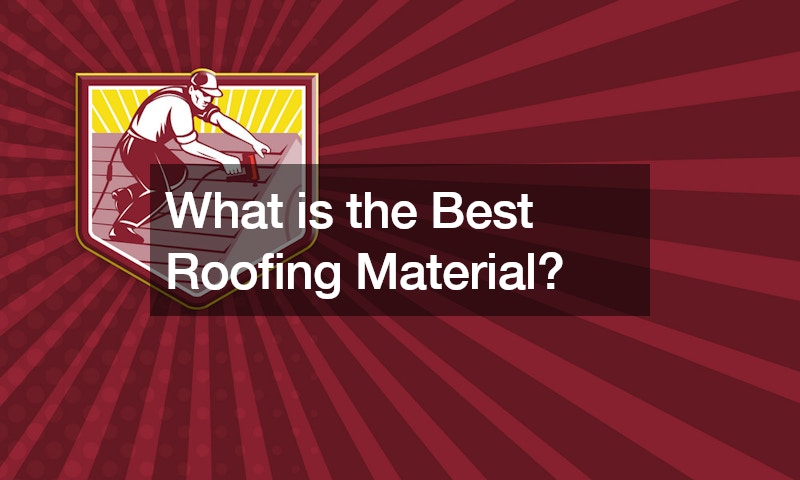When it comes to choosing the right roofing material, homeowners are often faced with a wide array of options. The type of roofing material you select can have a significant impact on the aesthetics, durability, and overall value of your home. Whether you are building a new home or replacing an old roof, understanding the different options available can help you make an informed decision. In this article, we will explore ten different types of roofing materials that you can get installed by a professional roofing company. We will also discuss the factors to consider when selecting light roofing materials and the benefits of working with experienced roof installers and contractors.
Roofing materials can be broadly classified into several categories based on their composition, application, and performance characteristics. Light roofing materials are particularly popular due to their ease of installation and cost-effectiveness. Furthermore, these materials often offer enhanced energy efficiency and environmental benefits. Whether you are interested in asphalt shingles, metal, tile, or wood, this guide will provide you with valuable insights into the best materials suited to your specific needs. So, let’s dive into the world of roofing and discover the ten types of roofing materials you can consider for your next roofing project.

Asphalt Shingles
Asphalt shingles are one of the most popular light roofing materials used in residential construction today. They are known for their affordability, ease of installation, and variety of styles and colors. Roofing companies often recommend asphalt shingles for homeowners looking for a durable yet budget-friendly option. These shingles are composed of a fiberglass mat coated with asphalt and granules, which provide protection against UV rays and weather elements.
When selecting asphalt shingles, it is important to consider the quality and grade of the material. Higher-grade shingles tend to offer better performance and longer lifespans. Working with reputable roof installers ensures that you get the most out of your investment. Additionally, asphalt shingles can be customized to mimic the appearance of more expensive roofing materials like slate or wood, providing homeowners with aesthetic flexibility.
Maintenance is relatively straightforward with asphalt shingles. Regular inspections and occasional cleaning by a roofing contractor can prolong the life of your roof. In the event of damage, asphalt shingles are relatively easy to repair or replace. This makes them a practical choice for homeowners seeking a balance between cost, durability, and ease of maintenance.
Metal
Metal roofing has gained popularity in recent years due to its exceptional durability and energy efficiency. Made from materials like steel, aluminum, and copper, metal roofs can last 50 years or more with proper maintenance. Roof installers often recommend metal roofing for homeowners in areas prone to extreme weather conditions, as these roofs can withstand high winds, heavy snowfall, and even fire. Furthermore, metal is one of the light roofing materials, making it suitable for structures that cannot support heavier roofs.
One of the main advantages of metal roofing is its energy efficiency. Metal roofs reflect solar radiant heat, which can reduce cooling costs by up to 25%. This makes them an eco-friendly option for homeowners looking to reduce their carbon footprint. Additionally, metal roofs are recyclable at the end of their lifespan, contributing to environmentally sustainable construction practices.
However, the initial cost of metal roofing can be higher compared to other materials. To maximize the benefits, it is advisable to work with experienced roofing companies that specialize in metal roofing installations. Proper installation is crucial to ensure that the roof performs optimally and meets warranty requirements. Regular inspections and maintenance by professional roofers can help identify any issues early and extend the lifespan of your roof.

Tile Roofing
Tile roofing is a centuries-old roofing solution that remains popular due to its aesthetic appeal and long-lasting durability. Made from materials like clay or concrete, tile roofs can last up to 100 years or more. Roofing companies often recommend tile roofing for homeowners looking for a traditional, elegant appearance. Moreover, tile is considered one of the light roofing materials, making it suitable for various architectural styles without exerting excessive weight on the structure.
One of the primary benefits of tile roofing is its resistance to fire, rot, and insects. These roofs are also effective in shedding water, and preventing leaks and water damage. In hot climates, tile roofs provide excellent insulation, helping to keep homes cool and reducing energy costs. Additionally, tile roofing is available in a variety of colors and styles, allowing homeowners to achieve a customized look that complements their home’s architecture.
Although tile roofing offers numerous advantages, it is important to note that proper installation and maintenance are key to its longevity. Working with experienced roofing contractors ensures that tiles are installed correctly and can withstand the elements. Regular inspections by local roofers can help identify and address any issues, such as broken or misaligned tiles before they lead to more significant problems.
Clay Roofing
Clay roofing is a type of tile roofing that has been used for centuries in various parts of the world. Known for its distinctive red or terracotta color, clay roofing adds a touch of elegance and character to any home. Roofing contractors often recommend clay tiles for their durability and resistance to harsh weather conditions. Like other light roofing materials, clay tiles do not put excessive strain on the building’s structure, making them suitable for both new constructions and roof replacements.
One of the standout features of clay roofing is its longevity. Clay tiles can last over 100 years with proper maintenance, making them a cost-effective investment in the long run. They are also resistant to fire, rot, and insect damage, providing a high level of protection for homes. Additionally, clay tiles offer excellent thermal insulation, helping to regulate indoor temperatures and reduce energy consumption.
While clay roofing has many benefits, it is important to work with skilled roofers for installation and maintenance. Proper installation is crucial to ensure that tiles are securely in place and can withstand weather-related stresses. Regular maintenance, such as cleaning and inspections by a roofing repair company, can help identify and address any issues promptly, ensuring the roof’s longevity and performance.

Slate Roofing
Slate roofing is a high-end roofing material known for its natural beauty and exceptional durability. Made from natural stone, slate tiles offer a unique, elegant appearance that can enhance the value of any home. Local roofers often recommend slate roofing for its longevity, as slate roofs can last well over 100 years with proper care. Despite being sturdy and durable, slate is considered one of the light roofing materials, making it a great choice for both new constructions and renovations.
One of the main advantages of slate roofing is its resistance to fire, water, and weathering. Slate tiles are dense and non-porous, making them impervious to moisture and frost damage. This makes slate an ideal choice for homes in areas with harsh weather conditions. Additionally, slate is a sustainable roofing option, as it is a natural material that can be recycled at the end of its lifespan.
However, the installation of a slate roof requires specialized skills and expertise. It is important to work with experienced roofing contractors who are knowledgeable in handling and installing slate tiles. Regular inspections and maintenance by professional roof installers can help identify and address any issues, such as cracked or loose tiles, ensuring the roof remains in optimal condition for many years.
Wood Shingles
Wood shingles are a classic roofing material that offers a unique, rustic charm. Made from natural wood, these shingles are often used in traditional and cottage-style homes. Emergency roof repair companies often recommend wood shingles for their natural beauty and ability to blend seamlessly with the surrounding environment. While wood shingles are considered light roofing materials, they provide excellent insulation and can help regulate indoor temperatures.
One of the key benefits of wood shingles is their natural resistance to UV rays and weathering. Over time, the wood develops a weathered patina that adds character and appeal to the roof. Additionally, wood shingles are recyclable and biodegradable, making them an eco-friendly roofing option. However, it is important to choose wood shingles that are treated for fire resistance and insect protection.
Proper installation and maintenance are crucial for the longevity of wood shingle roofs. Working with skilled roofing services ensures that shingles are installed correctly and can withstand the elements. Regular maintenance, such as cleaning and inspections by a roof repair company, can help identify and address any issues, such as rot or moss growth, ensuring the roof remains in good condition.

Solar Roofing
Solar roofing is a modern roofing solution that combines roofing materials with solar energy technology. These roofs are designed to generate electricity by harnessing sunlight, making them an excellent choice for environmentally conscious homeowners. Roofing services often recommend solar roofing for its energy-saving benefits and potential to reduce electricity bills. Additionally, solar roofing is considered one of the light roofing materials, making it suitable for various types of structures.
There are different types of solar roofing options available, including solar panels and solar shingles. Solar panels are typically installed over an existing roof, while solar shingles are integrated directly into the roofing material. Both options offer the benefits of renewable energy generation and reduced carbon footprint. Additionally, many roofing companies offer installation services for solar roofing, ensuring that the system is set up correctly and efficiently.
One of the key advantages of solar roofing is its ability to generate clean, renewable energy. This not only helps homeowners save on electricity costs but also reduces dependence on fossil fuels. Furthermore, solar roofing can increase the value of a home and may qualify for tax incentives and rebates. Regular maintenance and inspections by professional roofers can help ensure the optimal performance of the solar roofing system.
Green Roofing
Green roofing, also known as living roofs, is an innovative roofing solution that incorporates vegetation and plant life into the roof structure. These roofs are designed to support a variety of plants, creating a natural habitat and enhancing biodiversity. Roof repair companies often recommend green roofing for its environmental benefits and ability to improve air quality. Green roofing is also considered one of the light roofing materials, making it suitable for both residential and commercial buildings.
One of the main advantages of green roofing is its ability to regulate building temperatures. The vegetation layer provides natural insulation, reducing the need for heating and cooling and lowering energy costs. Additionally, green roofs can help manage stormwater runoff by absorbing and filtering rainwater, reducing the risk of flooding and water pollution. The presence of plants also helps to mitigate the urban heat island effect, making green roofing an eco-friendly choice.
However, the installation and maintenance of green roofs require specialized knowledge and expertise. Working with experienced roofing contractors ensures that the roof is designed and installed correctly to support plant life. Regular maintenance, such as watering, fertilization, and inspections by local roofers, is essential to ensure the health and longevity of the green roof. Proper care will ensure that the roof continues to provide environmental benefits for years to come.
Concrete Roofing
Concrete roofing is a durable and versatile roofing material that is widely used in both residential and commercial construction. Made from a mixture of cement, sand, and water, concrete tiles offer excellent durability and resistance to harsh weather conditions. Local roof replacement services often recommend concrete roofing for its strength and ability to withstand high winds, heavy rainfall, and fire. Despite being a strong material, concrete is considered one of the light roofing materials, making it suitable for various types of structures.
One of the key benefits of concrete roofing is its longevity. Concrete tiles can last for 50 years or more with proper maintenance, making them a cost-effective investment. Additionally, concrete tiles come in a variety of styles, colors, and textures, allowing homeowners to achieve a customized look that complements their home’s architecture. The material’s thermal mass also provides excellent insulation, helping to regulate indoor temperatures and reduce energy costs.
Proper installation and maintenance are crucial for the performance and longevity of concrete roofs. Working with reputable roofing companies ensures that tiles are installed correctly and can withstand the elements. Regular inspections and maintenance by professional roofers can help identify and address any issues, such as cracked or loose tiles, ensuring the roof remains in optimal condition.
Cedar Shakes
Cedar shakes are a type of wood roofing material known for their natural beauty and rustic charm. Made from split logs of cedar wood, these shakes provide a distinctive and textured appearance that can enhance the aesthetic appeal of any home. Roofers often recommend cedar shakes for their durability and ability to blend seamlessly with natural surroundings. As one of the light roofing materials, cedar shakes are suitable for various architectural styles and structures.
One of the primary benefits of cedar shakes is their natural resistance to UV rays, moisture, and insects. Cedar wood contains natural oils that help protect it from decay and weathering, making it a long-lasting roofing option. Additionally, cedar shakes offer excellent insulation properties, helping to regulate indoor temperatures and reduce energy consumption. The material’s natural appearance also improves with age, developing a beautiful silvery-gray patina over time.
Proper installation and maintenance are essential for the longevity and performance of cedar shake roofs. Working with experienced roofing services ensures that shakes are installed correctly and can withstand weather-related stresses. Regular maintenance, such as cleaning, treating for moss and algae, and inspections by a roofing contractor, can help preserve the wood’s appearance and functionality, ensuring the roof remains in good condition for many years.
Selecting the right roofing material is a crucial decision that can impact the aesthetics, durability, and value of your home. There are various types of light roofing materials available, each with its own set of advantages and disadvantages. Ultimately, the choice of roofing material depends on your specific needs, preferences, and budget. By understanding the options available and considering the expertise of professional roof installers and roofing services, you can make an informed decision that enhances the functionality and appearance of your home. Whether you are building a new home or replacing an old roof, selecting the right roofing material is an investment that will provide long-term benefits and peace of mind.



